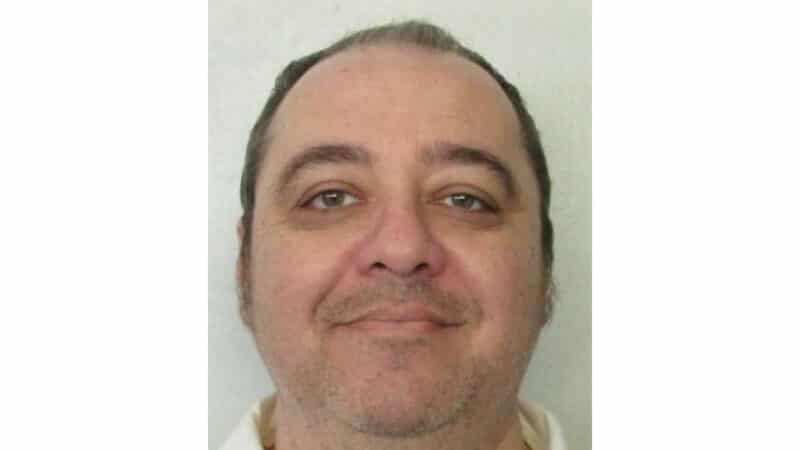Alabama executes a man with nitrogen gas, the first time the new method has been used
ATMORE, Ala. (AP) — Alabama executed a convicted murderer with nitrogen gas Thursday, putting him to death with a first-of-its-kind method that once again placed the U.S. at the forefront of the debate over capital punishment. The state said the method would be humane, but critics called it cruel and experimental.
Officials said Kenneth Eugene Smith, 58, was pronounced dead at 8:25 p.m. at an Alabama prison after breathing pure nitrogen gas through a face mask to cause oxygen deprivation. It marked the first time that a new execution method has been used in the United States since lethal injection, now the most commonly used method, was introduced in 1982.
The execution took about 22 minutes, and Smith appeared to remain conscious for several minutes. For at least two minutes, he appeared to shake and writhe on the gurney, sometimes pulling against the restraints. That was followed by several minutes of heavy breathing, until breathing was no longer perceptible.
In a final statement, Smith said: “Tonight Alabama causes humanity to take a step backwards. … I’m leaving with love, peace and light.”
He made the “I love you sign” with his hands toward family members who were witnesses. “Thank you for supporting me. Love, love all of you,” Smith said.
Alabama Gov. Kay Ivey said the execution was justice for the murder-for-hire killing of 45-year-old Elizabeth Sennett in 1988.
“After more than 30 years and attempt after attempt to game the system, Mr. Smith has answered for his horrendous crimes. … I pray that Elizabeth Sennett’s family can receive closure after all these years dealing with that great loss,” Ivey said in a statement.
Mike Sennett, the victim’s son, said Thursday night that Smith “had been incarcerated almost twice as long as I knew my mom.”
“Nothing happened here today is going to bring Mom back. It’s kind of a bittersweet day. We are not going to be jumping around, whooping and holler, hooray and all that. … I’ll end by saying Elizabeth Dorlene Sennett got her justice tonight,” he said.
The state had previously attempted to execute Smith in 2022, but the lethal injection was called off at the last minute because authorities couldn’t connect an IV line.
The execution came after a last-minute legal battle in which his attorneys contended the state was making him the test subject for an experimental execution method that could violate the constitutional ban on cruel and unusual punishment. Federal courts rejected Smith’s bid to block it, with the latest ruling coming Thursday night from the U.S. Supreme Court.
Justice Sonia Sotomayor, who along with two other liberal justices dissented, wrote: “Having failed to kill Smith on its first attempt, Alabama has selected him as its ‘guinea pig’ to test a method of execution never attempted before. The world is watching.”
The majority justices did not issue any statements.
The state had predicted the nitrogen gas would cause unconsciousness within seconds and death within minutes. State Attorney General Steve Marshall said late Thursday that nitrogen gas “was intended to be — and has now proved to be — an effective and humane method of execution.”
Asked about Smith’s shaking and convulsing on the gurney, Alabama corrections Commissioner John Q. Hamm said they appeared to be involuntary movements.
“That was all expected and was in the side effects that we’ve seen or researched on nitrogen hypoxia,” Hamm said. “Nothing was out of the ordinary from what we were expecting.”
Smith’s spiritual adviser, the Rev. Jeff Hood, said the execution did not match the state attorney general’s prediction in court filings that Smith would lose consciousness in seconds followed by death within minutes.
“We didn’t see somebody go unconscious in 30 seconds. What we saw was minutes of someone struggling for their life,” said Hood, who attended the execution.
Some doctors and organizations had expressed alarm about the method, and Smith’s attorneys asked the Supreme Court to halt the execution to review claims that it violates the constitutional ban on cruel and unusual punishment and deserved more legal scrutiny before it was used on a person.
“There is little research regarding death by nitrogen hypoxia. When the State is considering using a novel form of execution that has never been attempted anywhere, the public has an interest in ensuring the State has researched the method adequately and established procedures to minimize the pain and suffering of the condemned person,” Smith’s attorneys wrote.
In her dissent, Sotomayor said Alabama has shrouded its execution protocol in secrecy, releasing only a heavily redacted version. She also said Smith should have been allowed to obtain evidence about the protocol and to proceed with his legal challenge.
“That information is important not only to Smith, who has an extra reason to fear the gurney, but to anyone the State seeks to execute after him using this novel method,” Sotomayor wrote.
“Twice now this Court has ignored Smith’s warning that Alabama will subject him to an unconstitutional risk of pain,” Sotomayor wrote. “I sincerely hope that he is not proven correct a second time.”
Justice Elena Kagan wrote a separate dissent and was joined by Justice Ketanji Brown Jackson.
In his final hours, Smith met with family members and his spiritual adviser, according to a prison spokesperson.
He ate a last meal of T-bone steak, hash browns, toast and eggs slathered in A1 steak sauce, Hood said by telephone before the execution was carried out.
“He’s terrified at the torture that could come. But he’s also at peace. One of the things he told me is he is finally getting out,” Hood said.
The execution protocol called for Smith to be strapped to a gurney in the execution chamber — the same one where he was strapped down for several hours during the lethal injection attempt — and a “full facepiece supplied air respirator” to be placed over his face. After he had a chance to make a final statement, the warden, from another room, was to activate the nitrogen gas. It would be administered through the mask for at least 15 minutes or “five minutes following a flatline indication on the EKG, whichever is longer,” according to the state protocol.
Hamm, the corrections commissioner, confirmed afterward that the gas was flowing for about 15 minutes.
Sant’Egidio Community, a Vatican-affiliated Catholic charity based in Rome, had urged Alabama not to go through with the execution, saying the method is “barbarous” and “uncivilized” and would bring “indelible shame” to the state. And experts appointed by the U.N. Human Rights Council cautioned they believe the execution method could violate the prohibition on torture.
Some states are looking for new ways to execute people because the drugs used in lethal injections have become difficult to find. Three states — Alabama, Mississippi and Oklahoma — have authorized nitrogen hypoxia as an execution method, but no state had attempted to use the untested method until now.
Smith’s attorneys had raised concerns that he could choke to death on his own vomit as the nitrogen gas flows. The state made a last-minute procedural change so he would not be allowed food in the eight hours beforehand.
Sennett was found dead in her home March 18, 1988, with eight stab wounds in the chest and one on each side of her neck. Smith was one of two men convicted in the killing. The other, John Forrest Parker, was executed in 2010.
Prosecutors said they were each paid $1,000 to kill Sennett on behalf of her pastor husband, who was deeply in debt and wanted to collect on insurance. The husband, Charles Sennett Sr., killed himself when the investigation focused on him as a suspect, according to court documents.
Smith’s 1989 conviction was overturned, but he was convicted again in 1996. The jury recommended a life sentence by 11-1, but a judge overrode that and sentenced him to death. Alabama no longer allows a judge to override a jury’s death penalty decision.
For Ukrainians, a nuclear missile museum is a bitter reminder of what the country gave up
The Museum of Strategic Missile Forces tells the story of how Ukraine dismantled its nuclear weapons arsenal after independence in 1991. Today many Ukrainians believe that decision to give up nukes was a mistake.
Jeffrey R. Holland, next in line to lead Church of Jesus Christ of Latter-day Saints, dies at 85
Jeffrey R. Holland led the Quorum of the Twelve Apostles, a key governing body. He was next in line to become the church's president.
Winter storm brings heavy snow and ice to busy holiday travel weekend
A powerful winter storm is impacting parts of the U.S. with major snowfall, ice, and below zero wind chills. The conditions are disrupting holiday travel and could last through next week.
Disability rights advocate Bob Kafka dead at 79
Bob Kafka was an organizer with ADAPT (American Disabled for Attendant Programs Today), a group which advocates for policy change to support people with disabilities.
‘It’s behind you!’ How Britain goes wild for pantomimes during the holidays
Pantomimes are plays based on a well-known story — often a fairy tale — which are given a bawdy twist. The audience is expected to join in throughout, shouting as loudly as they can.
Kennedy Center vows to sue musician who canceled performance over Trump name change
The Kennedy Center is planning legal action after jazz musician Chuck Redd canceled an annual holiday concert. Redd pulled out after President Trump's name appeared on the building.








